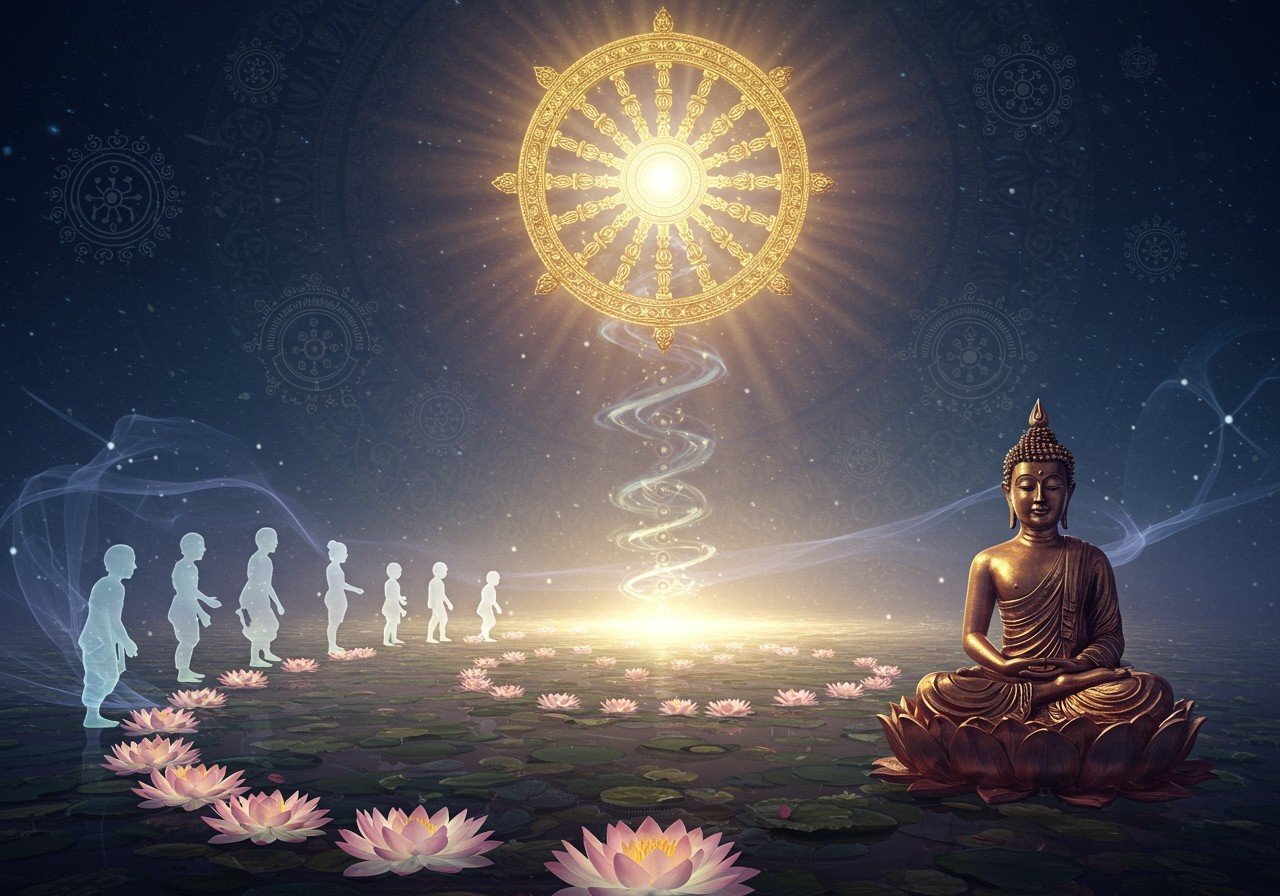
Buddhism, a major world religion with origins in India, offers profound insights into existence, suffering, and the path to enlightenment. Karma and rebirth, two core Buddhist concepts, shape the ethical and spiritual practices of millions worldwide. This article explores these concepts, their significance, and how they interconnect within the cycle of life and death.
The Buddhist Concept of Karma
Karma, a Sanskrit word meaning ‘action,’ is a fundamental principle in Buddhism. It represents the ethical principle of cause and effect, where intentional actions lead to corresponding results. It emphasizes the importance of mindful actions and their impact on our present and future lives. In Buddhism, karma refers to intentional actions that have ethical consequences. These actions lead to effects that begin immediately and continue in various directions.
- Origins: Karma originated within ancient Indian traditions and was later adopted and refined by Buddhism. It’s a concept that has resonated for millennia, shaping ethical frameworks across various cultures and spiritual traditions.
- Types of Karma: Buddhism recognizes good, bad, and neutral karma. These karmic imprints accumulate throughout our lifetimes, influencing our experiences and future rebirths. Good karma arises from virtuous actions, bad karma from harmful ones, and neutral karma from actions without significant ethical weight.
- Role of Intention (Cetana): The intention behind an action holds significant weight in determining its karmic quality. A seemingly positive action performed with malicious intent can generate negative karma, while a well-intentioned action that inadvertently causes harm may have less severe karmic repercussions.
- Daily Life Examples: Ethical conduct (sila) plays a crucial role in generating positive karma in everyday life. Acts of kindness, generosity, truthful speech, and non-violence contribute to positive karmic accumulation, while harmful actions, dishonesty, and causing suffering create negative karma.
- Misconceptions: Karma is not simply a system of divine punishment or reward. It’s a natural law of cause and effect, a process of learning and growth that guides us toward spiritual maturity. It encourages us to take responsibility for our actions and their consequences.
- Four Noble Truths: Karma is directly related to the Second and Third Noble Truths, which address the nature of suffering and the possibility of its cessation. By understanding the workings of karma, we gain insight into the root causes of suffering and the path towards liberation.
- Impact on Samsara: Karma significantly influences the cycle of birth, death, and rebirth (samsara). Our actions in this life shape the conditions of our future lives, determining the realms of existence we are reborn into.
The Cycle of Rebirth (Samsara)
Samsara, the cycle of rebirth, is a central tenet of Buddhist cosmology. It describes the continuous cycle of life, death, and reincarnation, driven by karma and characterized by suffering. Rebirth is the concept that a sentient being’s actions result in a new existence after death in a cycle called saṃsāra, which is considered unsatisfactory and painful. The cycle ends only if Nirvana, or liberation, is achieved by extinguishing craving. Karma and rebirth are foundational doctrines of Buddhism.
- Definition: Samsara is the ongoing process of birth, death, and rebirth, driven by karma and conditioned by ignorance and craving. It is considered a state of suffering due to its impermanent and unsatisfactory nature.
- Six Realms of Existence: Buddhist cosmology describes six realms of existence: gods, demi-gods, humans, animals, hungry ghosts, and hell beings. The realm into which a being is reborn is determined by their accumulated karma.
- Influence of Karma: Karma directly dictates the realm of rebirth. Positive karma can lead to rebirth in higher realms with greater happiness, while negative karma can result in rebirth in lower realms characterized by suffering.
- Perpetuation Factors: Ignorance (avidya) and craving (tanha) are the primary forces that perpetuate the cycle of samsara. By clinging to the illusion of a separate self and craving for impermanent things, we fuel the cycle of birth, death, and rebirth.
- Spiritual Practice Goal: The ultimate goal of Buddhist practice is liberation (moksha) from samsara through the attainment of enlightenment (nirvana). Nirvana represents the cessation of suffering and the liberation from the cycle of rebirth.
- Rebirth Process: In Tibetan Buddhism, the rebirth process involves an intermediate state called the bardo. This transitional period between death and rebirth is believed to significantly influence the next life.
- Comparisons: While both Buddhism and Hinduism embrace the concept of rebirth, there are key differences in their understanding of the process. Buddhism does not posit a permanent soul that transmigrates, but rather a stream of consciousness that continues from one life to the next.
- Textual Examples: Buddhist scriptures, such as the Jataka tales, provide numerous examples of rebirth and the workings of karma, illustrating how actions in past lives shape present circumstances and future rebirths.
Interconnection of Karma and Rebirth
Karma and rebirth are inextricably linked in Buddhist philosophy. They form the foundation of the cycle of samsara and the path to liberation.
- Accumulated Karma Effects: The karma we accumulate throughout our past lives significantly impacts our present circumstances and future rebirths. Our current life is the result of past actions, and our present actions shape our future lives.
- Law of Dependent Origination (Pratītyasamutpāda): This fundamental Buddhist principle explains the interconnectedness of all phenomena and the cyclical nature of cause and effect, including the cycle of rebirth. It highlights the interdependence of all things and the absence of a permanent, independent self.
- Stories from Buddhist Scriptures: Jataka tales, which recount the previous lives of the Buddha, offer compelling narratives that illustrate the workings of karma and rebirth. These stories provide valuable lessons on the consequences of actions and the importance of ethical conduct.
- Mindfulness and Ethical Living: Cultivating mindfulness and living ethically are essential for generating positive karma and creating the conditions for favorable rebirths. By being mindful of our actions, thoughts, and intentions, we can cultivate wholesome karma and move towards liberation.
- Meditation and Spiritual Practices: Meditation and other spiritual practices are crucial for weakening the grip of ignorance and craving, which perpetuate samsara. These practices help us gain insight into the nature of reality and cultivate wisdom and compassion, paving the way for liberation.
- Understanding Karma and Rebirth: A clear understanding of karma and rebirth is essential for progressing on the path to enlightenment. By comprehending these principles, we can make informed choices that lead to positive karmic outcomes and ultimately, liberation from suffering.
- Practical Advice: Integrating the principles of karma and rebirth into our daily lives fosters spiritual growth and ethical behavior. Regularly reflecting on our actions and their potential consequences encourages us to act with greater awareness and compassion.
Poojn.in: Supporting Your Spiritual Journey
Poojn.in, India’s leading online store for spiritual and cultural goods, offers a wide selection of products to support your Buddhist practice. Explore our collection of mala beads, perfect for mindful recitation and meditation, and enhance your practice with high-quality incense to create a serene atmosphere. Discover a range of products designed to deepen your understanding and practice of Buddhist principles.
Conclusion
Understanding karma and rebirth provides invaluable insights into the nature of existence, suffering, and the path to enlightenment in Buddhism. These teachings offer guidance for ethical conduct, spiritual practice, and personal growth. By integrating these principles into our daily lives, we can cultivate compassion, mindfulness, and purpose, ultimately moving closer to liberation from samsara and the attainment of nirvana.


